The rapid advancement of artificial intelligence has given rise to a powerful technology known as generative AI. This groundbreaking innovation is revolutionizing how content, art, and various industries operate. From generating human-like text to creating stunning visuals, generative AI is reshaping the digital landscape and offering new opportunities for businesses and individuals alike.
As AI models become more sophisticated, they are now capable of performing tasks that were once exclusive to human creativity. Whether it’s crafting compelling blog articles, composing music, or designing intricate artworks, generative AI has proven its versatility. In this article, we explore the evolution of generative AI, its applications, and its impact on multiple industries.
Understanding Generative AI
Generative AI refers to artificial intelligence systems designed to generate content autonomously. These models learn from vast amounts of data and use complex algorithms to produce new, unique outputs. Unlike traditional AI, which focuses on automation and pattern recognition, generative AI creates original content, mimicking human creativity and ingenuity.
The technology behind generative AI is primarily based on deep learning and neural networks. Large-scale models, such as GPT (Generative Pre-trained Transformer) and DALL·E, have demonstrated remarkable capabilities in generating text, images, and even videos. These AI-driven models can understand prompts, analyze patterns, and create content that is often indistinguishable from human-generated work.
The Role of Generative AI in Content Creation
One of the most significant impacts of generative AI is in the field of content creation. Businesses, marketers, and bloggers are leveraging AI-powered tools to generate high-quality articles, product descriptions, and marketing copies within seconds. This has transformed the digital content industry, making it easier for creators to produce consistent and engaging material.
With the ability to analyze search trends and optimize for SEO, generative AI enhances content visibility and improves online presence. Bloggers and website owners can now streamline their content creation process, saving time and effort while maintaining the quality of their work. Additionally, AI-generated content is increasingly being used for social media posts, newsletters, and even video scripts.
Revolutionizing Art and Design with AI
Generative AI is not limited to text-based content—it has also made significant strides in the art and design industry. AI-powered tools can create digital paintings, graphic designs, and even realistic portraits based on user inputs. Artists and designers are using these AI-generated visuals as inspiration, blending traditional creativity with advanced technology.
Platforms like Deep Dream, Artbreeder, and DALLE have allowed users to experiment with AI-generated art, producing stunning visuals in a matter of seconds. This fusion of AI and human creativity is opening new possibilities for digital artists, game developers, and even filmmakers who need unique visual elements.
The Impact of Generative AI on Music and Audio Production
Beyond text and visuals, generative AI is also reshaping the world of music and audio production. AI-powered platforms such as OpenAI’s Jukebox and Google’s Magenta can compose original pieces of music, replicate specific styles, and even create soundtracks tailored to different moods and themes.
Musicians and composers are integrating AI-generated music into their work, using it as a foundation for further refinement. This technology is particularly beneficial for content creators who require royalty-free music for videos, podcasts, and advertisements. By harnessing the power of generative AI, artists can explore new genres and experiment with innovative compositions.
Generative AI in the Business World

Businesses across various industries are adopting generative AI to improve efficiency and innovation. From automated customer support chatbots to AI-generated product recommendations, companies are leveraging AI to enhance user experiences and streamline operations. AI-driven copywriting tools are also helping brands create personalized marketing campaigns that resonate with their target audiences.
In e-commerce, generative AI is being used to generate product descriptions, reviews, and promotional content. This automation not only saves time but also ensures consistency across multiple platforms. Similarly, AI-powered video generation is transforming digital advertising, enabling brands to produce engaging video content without extensive production costs.
Ethical Considerations and Challenges of Generative AI
Despite its numerous advantages, generative AI presents ethical challenges that must be addressed. One major concern is the potential for misinformation and deepfake technology. AI-generated content can be used to create misleading narratives, posing risks to credibility and trust. As a result, there is a growing need for regulations and ethical guidelines to prevent misuse.
Another challenge is the impact on employment. As AI continues to automate creative tasks, there is concern about job displacement in fields such as content writing, graphic design, and even music composition. However, experts argue that AI should be seen as a tool for augmentation rather than a replacement for human creativity.
The Future of Generative AI
The future of generative AI is promising, with ongoing research and advancements paving the way for even more sophisticated applications. AI models are continuously improving in terms of accuracy, creativity, and adaptability. As these technologies evolve, they will further integrate into everyday life, enhancing productivity and enabling new forms of creative expression.
Industries such as healthcare, education, and entertainment are expected to benefit from generative AI innovations. AI-generated medical reports, personalized learning materials, and interactive storytelling are just a few of the possibilities on the horizon. The key to harnessing the full potential of generative AI lies in responsible usage and ethical implementation.
Conclusion
Generative AI is reshaping the digital landscape, transforming the way we create content, art, music, and beyond. Its ability to generate high-quality material quickly and efficiently has made it an invaluable tool for businesses and individuals alike. While challenges remain, the potential benefits of generative AI are vast, offering new opportunities for creativity, automation, and innovation.
As AI technology continues to advance, it is essential to strike a balance between leveraging its capabilities and maintaining ethical standards. By doing so, we can fully embrace the power of generative AI while ensuring a future where creativity and human ingenuity remain at the forefront of innovation.
